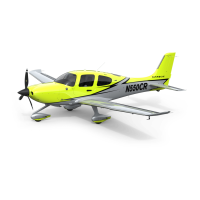CIRRUS AIRPLANE MAINTENANCE MANUAL MODELS SR22 AND SR22T
24-30
Page 7
All
EFFECTIVITY:
C. Alternator 1 (See Figure 24-302)
The front alternator (alternator 1) is mounted directly to the front of the engine on the co-pilots’ side.
Serials 22-0002 & subs w/o Fan, 22-1863 & subs w/o Air Conditioning: Alternator 1 is a 60-amp (rated
at 58-amps) engine-driven alternator.
Serials 22-1863 & subs w/ Fan, 22-1863 & subs w/ Air Conditioning, or Serials w/ Perspective Avion-
ics: Alternator 1 is a 100-amp engine-driven alternator.
Alternator 1 is controlled by the ALT 1 master switch located in the bolster panel. Battery 1 and alterna-
tor 1 are independently controlled and can be alternately connected to Main Bus 2. Failure or malfunc-
tion of alternator 1 will not impair the capability of the main battery to provide power to Main Bus 2.
Failure or malfunction of either or both alternators will not impair the capability of either battery to
power the essential load circuits, because each of these power sources feed into the Essential Bus. If
either alternator is lost, the other alternator and both batteries are still capable of feeding the Essential
Bus. In addition, each alternator or battery can be manually disconnected by switching the appropriate
master bolster switch located on the pilot's bolster switch panel.
D. Alternator 2 (See Figure 24-303)
Serials w/o Perspective Avionics: Alternator 2 is a 20-amp engine-driven alternator mounted directly to
the aft engine accessory pad which is located at the rear of the engine. Alternator 2 supplies electrical
power to the Essential Bus through a 5-amp circuit breaker located in the circuit breaker panel. Alter-
nator 2 is controlled by the ALT 2 switch located in the bolster panel. If alternator 2 fails while in opera-
tion, the Essential Bus will then get electrical power from alternator 1, battery 1, and/or battery 2.
Serials w/ Perspective Avionics: Alternator 2 is a 70-amp belt-driven alternator mounted to the left front
of the engine. Alternator 2 supplies electrical power to Essential Bus 2 through a 5-amp circuit breaker
located in the circuit breaker panel. Alternator 2 is controlled by the ALT 2 switch located in the bolster
panel. If alternator 2 fails while in operation, the Essential Bus will then get electrical power from alter-
nator 1, battery 1, and/or battery 2.
E. Master Control Unit (MCU) (See Figure 24-305)
The MCU is an integrated component which ensures proper electrical output over the entire tempera-
ture and RPM range of the alternator system by regulating and distributing alternator output. The MCU
is mounted to the forward side of the firewall, on the pilot’s side.
(1) Master Control Unit 100 and 120 - Serials 22-0002 thru 22-1601, 22-1603 thru 22-1643, 22-
1645 thru 22-1662
The MCU controls alternator 1, alternator 2, starter, landing light, external power, and the power
generation system annunciation. The MCU provides protection for external power reverse polar-
ity and alternator overvoltage situations. The MCU also provides low voltage annunciation and
an overload annunciation for ALT 1 and ALT 2 fail annunciators in the instrument panel.
The bus structure of the MCU and the circuit breaker panel allows all power devices to feed into
the Essential Bus during emergencies. This action is automatic and does not require pilot inter-
vention. The Main and Essential Buses are separated via diodes which allow the Main Bus to
feed into the Essential Bus during failures of Alternator 2 or Battery 2. The MCU regulates Alter-
nator 1 to 28 VDC, while Alternator 2 is regulated to 28.75 VDC which ensures the diode sepa-
rates the buses during normal operation.
The MCU used on this airplane contains a landing light relay, battery relay, ground power relay,
starter relay, ammeter transducer, 15-amp landing light circuit breaker, two buses (one essential
and one non-essential), two field control modules, three current sensors, and five 25-amp distri-
bution feeder circuit breakers.
The pilot has access to the alternator circuit breakers, which are located in the circuit breaker
panel, during flight. If the system is generating more than 31.75 ± 0.25 V, the corresponding
alternator circuit breaker will open, preventing further power generation by that alternator.
15 Dec 2014

